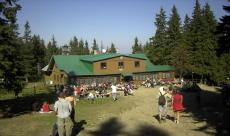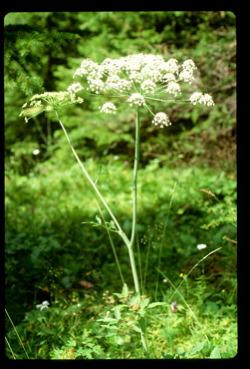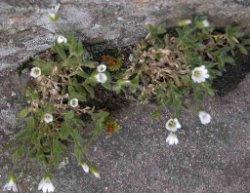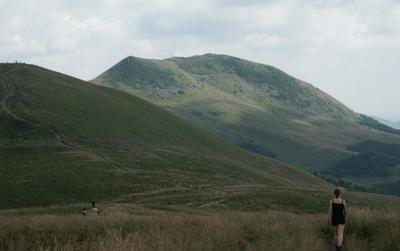Some of Polish reserves of biosphere
Today I would like to finish my writing about Babia Góra National Park and compare it/write something more about two other Polish mountaineous National Parks also recognized by UNESCO as reserves of biosphere. Of course these all pieces of information I am going to present today connected both with Babiogorski National Park and Tatra National Park + Bieszczady National Park are merely introduction to the amount of things and stories that can be (and party will be written by me in my next entries) But to be more certain that things I am explaining/describing are easy to be understood/imagine to my readers I need to present another map here (very similar to the one I enclosed to this blog several days ago but enriched with some new places – I mean rings and circles).

So as you know Babia Góra National Park is recognized as the reserve of a biosphere by UNESCO. But it isn’t the only such a region in Poland. There are at least two others as unique as it and also recognized as reserves of the biosphere: namely Tatra National Park and Bieszczady National Park.
So let me to start with Tatra National Park – the most crowded Polish National Park probably but surely not the cheapest one. On the map that I have enclosed above you can find it in the southern part of Poland (beneath a big brown line marking range of Polish Carpathian mountains- it is marked as a pink spot circled with a red ring)– Tatra National Park is the most south protruding Polish National Park (except of the most south-east sticking out Bieszczady National Park that I will introduce in a moment).
In 1992 UNESCO recognized Tatra National Park of Poland and Slovakia as “Tatra” transborder reserve of the biosphere. Tatra National Park was formally founded in 1954 and on Polish side it comprises whole area of Polish Tatras. It is full with characteristic diversified sculpture of the earth surface which is composed of sharp mountain peaks (the highest peak on Polish side is Rysy 2499) , post-glacial hollows (for example the hollow of Czarny Staw I will write about more soon), numerous lakes called ponds (for example Morskie Oko with the surface of 34 ha) and caves (the deepest one is Wielka Śnieżna – over 780 m).
What is very important the flora of Tatra mountains has the layer arrangement and differentiantion. First fir-beech forests in the lower prealps (to 1250 m), then spruces forests in the upper prealps (to 1550 m), next the layer of dwarf mountain pines (to 1800), at last the alpine layer (to 2300) and the peak layer above this altitude. Why am I writing about these layers so scrupulously? Because the same arrangement of plant cover apart from Tatra mountains you can meet in Poland only on Babia Góra slopes, however the layer plant arrangement on Babia Gora slopes is lowered about 100-150 metres on average comparing with plant layers in Tatra mountains (compare this with pictures from Babia Góra National Park from my earlier entries- Markowe Szczawiny chalet in Babia Góra National Park is about 1100 metres above the sea level and at this altitude you can observe how beech-forest is replaced by big spruces). In other Polish mountains nowhere you will meet such a regular 4 layer configuration of flora because they are lower Beneath I would like to enclose to you two pictures with in-famous Markowe Szczawiny chalet:

Writing about Babia Góra and Babogórski National Park (a black spot marked with a red ring in the southern part of Poland on the map above-next to green spot marking Beskidy range within Silesian Voivedship) except of things that Babia Gora National Park was founded in 1954 and UNESCO recognized it as the world reserve of the biosphere in 1976 I think it is worthy to mention that Babia Góra which is built of magurski sandstone constitutes a separate ridge of the Beskid Wysoki what is mostly easy to observe on the map that I placed in this blog on 1 August 2005 showing a distance between Żywiecki Nature Park within Silesian Voivodeship and Babia Góra National Park within neighbourng Malopolskie Voivodeship. This separate ridge of Babia Góra runs evenly with a paralel of latitude about 11 kilomotres reaching maximum hight of 1725 on the peak of Diablak. There are about 700 species of vascular plants in the Babia Góra National Park including 70 alpine species and 54 legally protected species. Babia Góra is also the only locality for laserwort (Laserpitium archangelica) and alpine cerastium Cerastium alpinum. The fauna of vertebrates comprises 166 species including 2 species of fish, 5 species of amphibians, 5 species of reptiles, 115 species of birds, 38 species of mammals (including the bear and the wolf).
The fauna of Babia Góra invetebrates comprises 2437 species including over 30 endemic species (by the way do you know what means endemic?) . As deals invetebrates of Babia Góra cockchafers make a group of 1300 species inside it.
So compare please 166 vetebrates versus 2437 invetebrates with 1300 cockchafers within it. Easy to guess that planet Earth belongs rather to little creatures than to the big ones and the little increase its biodiversity.
Beneath look at the pictures with endemic flora components of Babia Góra slopes – Laserpitium archanglica on the first and Cerastium alpinum on the next:


I hope you will learn what ENDEMIC means if you don’t understand this term.
The last of Polish mountaineous National Parks that are also recognized by UNESCO as reserves of the biosphere I would like to introduce in this long entry of mine today is Bieszczady National Park. Bieszczady National Park on the map above are marked as a yellow spot circled with a red ring and lie in the most south–east sticking out part of Poland. As you can easily notice this National Park is much further on the east compared to other Parks I have described till now. It lies among Polish, Slovakian and Ukrainian (the last is marked on the map above with a violet line) border.
Bieszczady National Park was made in 1973 and in 1991 it was enlarged. In 1992 UNESCO recognized the international Polish-Slovakian-Ukrainian reserve of the biosphere called “The Eastern Carpathians”. The Polish part of this reserve contains Bieszczadzki National Park and two Landscape Parks: ”Cieśniańsko-Wetliński” and “The San Valley”. It is a very long story to write about how beautiful Bieszczady National Park is but what is the most important probably Bieszczadzki National Park is one of the wildest places in whole Poland. People at the eastern border don’t have such a comfortable life like the ones in western part of Poland. Much less developed tourism there – less people is surely an advantage but state of roads, sleeping base in mountains (very few chalets at all and conditions inside it worse than tragic mostly), hot water in a tap and if you can have it at last is really an expensive extravagance. Look at the map above – to get into Bieszczady from my place of living within Silesia voivodeship (white spot marked with a red ring) you need to get into Katowice, then to Krakow –circled with a grey ring near to brown spot – this is Ojcowski National Park I will describe soon -then to Rzeszów (underlined with a black line) and than you have to find another train to Zagórze (place marked as a red spot on brown line of Carpathian mountains range). Believe me or not it takes 2-3 hours to get to Zagórze from Rzeszów and then you have to find a bus to the centre of Bieszczady National Park and it takes about 4 hours to get into Park from red spot of Zagórze. It is really incredible what drivers can do do while driving. Every 15 minutes a break for another 15 minutes and from time to time half of hour of break. Really nightmare.
So changing topic what is specially beautiful and famous as deals nature within Bieszczady National Park are unique mountain pastures – so called “połoniny” that are wonderful place for resting and many songs have been written about these pastures in Bieszczady. The biggest and most beautiful of them are Caryńska and Wetlińska pastures. They both are in northern part of Polish Bieszczadzki National Park. Southern part of the Bieszczady National Park comprises its highest parts with the main peak Tarnica (1346 metres above sea level).
What is important in the Bieszczady unlike in other parts of Carpathians , the upper border of the forest (1150-1200 metres above sea level) is formed by distorted dwarf beeches of the lower prealps. And above the forest there are the mentioned above beautiful and full of colourful flowers pastures with rocks sticking out here and there.
Of course I could write many other things about Bieszczady but that’s immpossible so I finish for today: Beneath I present pictures from Bieszczady National Park.
On the first you can see pastures:





and now some pictures with the highest peak of Bieszczady– Tarnica.



Going into Bieszczady the best is to have a base in Ustrzyki Górne – you have to find a bus in Zagórze to Ustrzyki Górne. It is not long to climb everywhere from that village. Also you can easily find a chalet to stay there. Prices are reasonable compared to Tatra mountains. And definitely less people than in Tatra-specially in the autumn. I would recommend to go into Bieszczady in September cause red colour of hawthorns sticking out among rocks on the pastures, these corridors of red hawthorns you have to go into to pass through them can really make you stop breathing. Also June is a good time when you want to see colorful blooming Bieszczady pastures.
To be continued soon.

0 Comments:
Post a Comment
<< Home